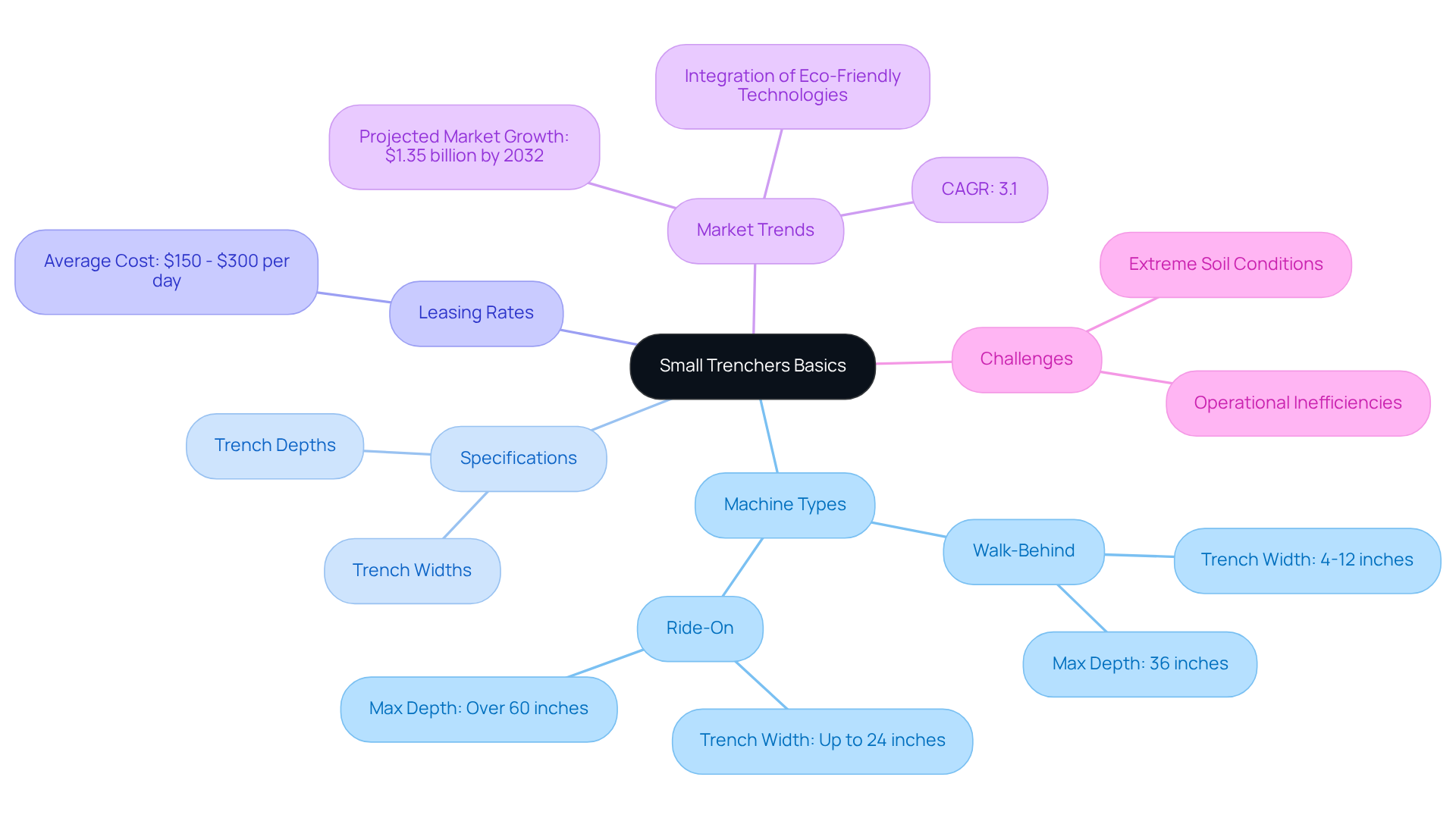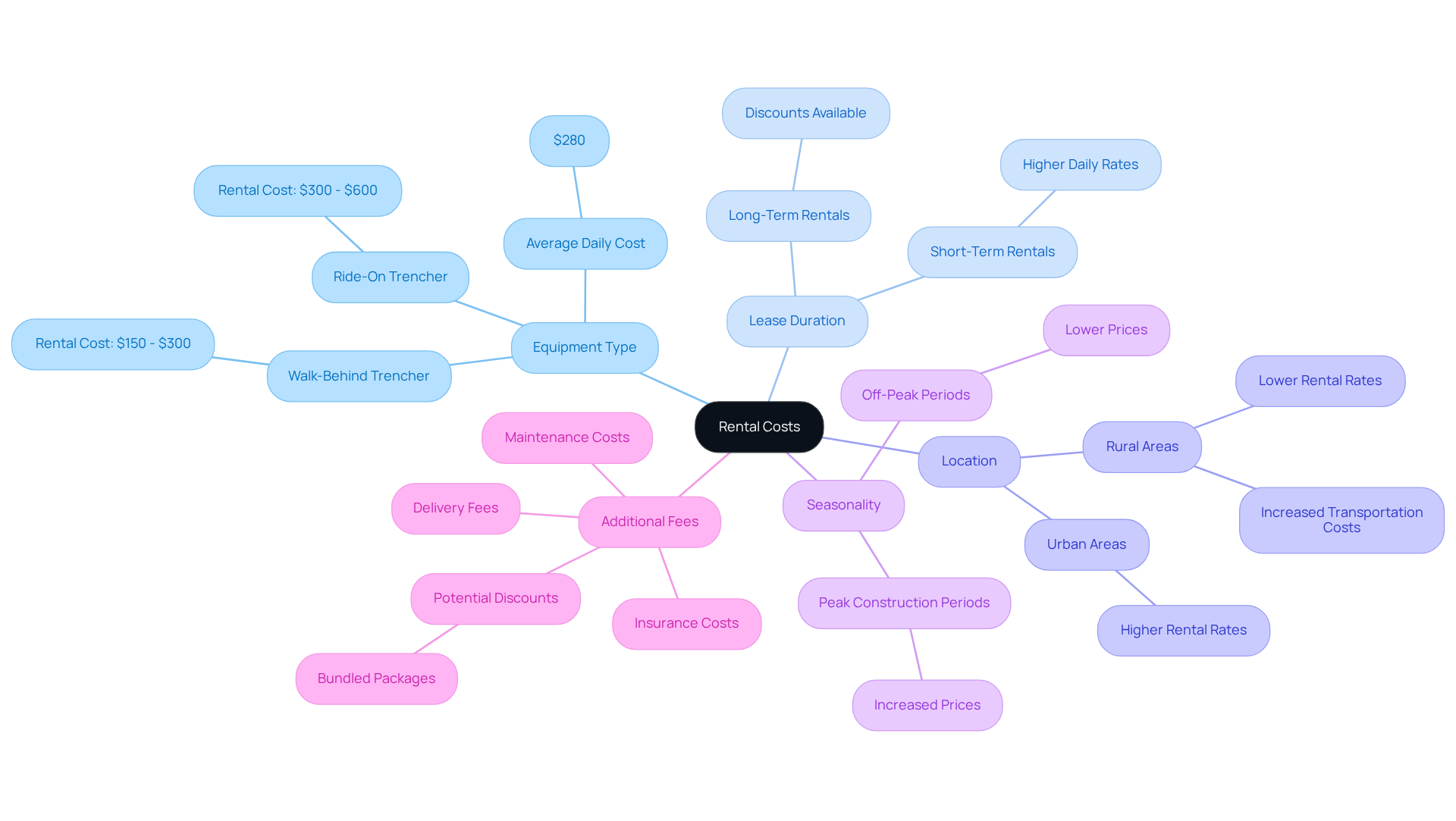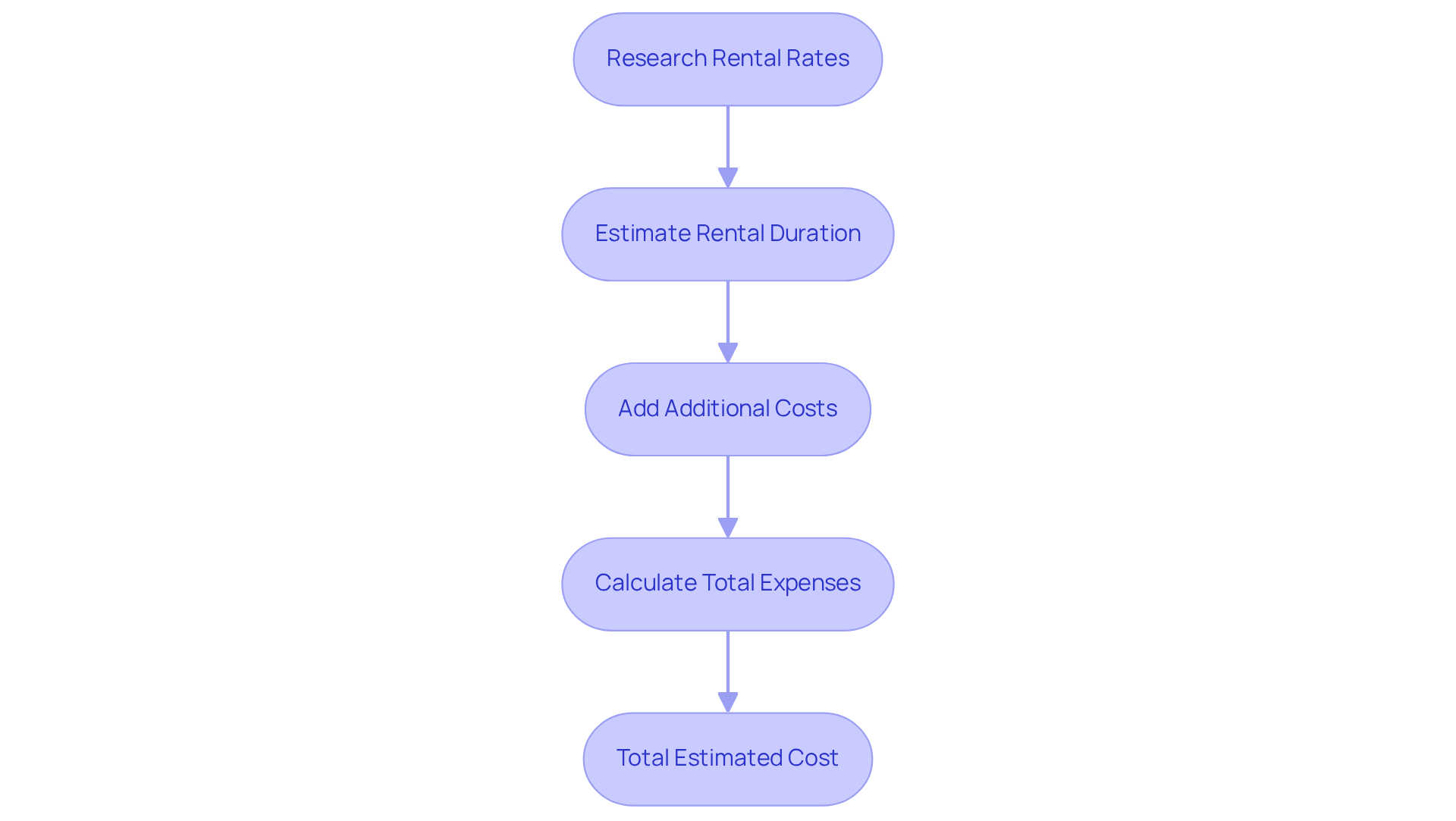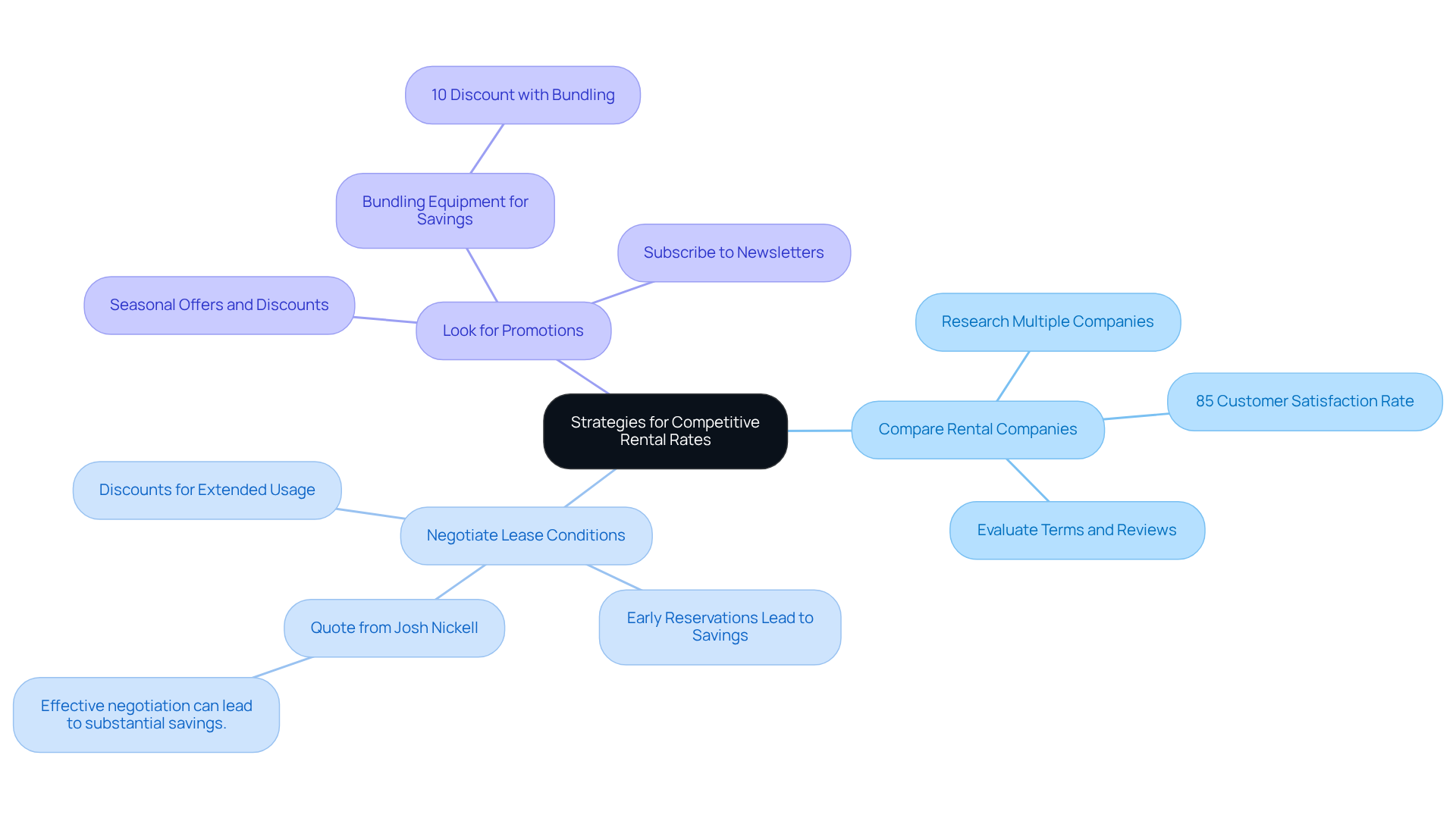Overview
Renting a small trencher typically incurs costs ranging from $150 to $600 per day. This price is influenced by various factors, including the type of equipment, lease duration, location, and seasonal demand. Understanding these variables is crucial for effective budgeting. In addition, employing strategies for comparing rates and negotiating terms can significantly reduce unexpected expenses in trenching projects.
By grasping the nuances of equipment rental, you can optimize your project’s financial planning. For instance, knowing the peak seasons for trenching services can help you anticipate price fluctuations. Furthermore, leveraging tools for rate comparison ensures you secure the best deal available. Ultimately, these insights empower you to make informed decisions that align with your budgetary constraints.
In conclusion, a thorough understanding of rental costs and strategies for effective negotiation not only enhances your budgeting efforts but also mitigates unforeseen expenses. Engage with our services today to take the first step toward optimizing your trenching projects.
Key Highlights:
- Small trenchers are vital for tasks like irrigation installation, pipe laying, and landscaping.
- Walk-behind trenchers are suited for small tasks, with trench widths of 4-12 inches and depths up to 36 inches.
- Ride-on trenchers are designed for larger projects, offering widths up to 24 inches and depths exceeding 60 inches.
- Leasing rates for small trenchers typically range from $150 to $600 per day, depending on the machine type.
- Factors affecting rental costs include equipment type, lease duration, location, seasonality, and additional fees.
- Extended rental periods often lead to lower daily rates, making it cost-effective for longer projects.
- Urban areas usually have higher rental rates due to demand, while rural areas may have lower prices but higher transport costs.
- To estimate rental costs, consider daily rates, rental duration, additional fees, and taxes.
- Strategies to find competitive rental rates include comparing companies, negotiating terms, and looking for promotions.
- Bundling equipment rentals can lead to discounts, optimising budget efficiency.
Introduction
Understanding the costs associated with renting a small trencher is pivotal for the success of construction and landscaping projects. Average rental rates fluctuate between $150 and $600 per day, depending on the machine type and rental duration. For project managers, navigating the variables that affect these prices is essential. Amidst the myriad of options available, how can one ensure they are making the most cost-effective choice? This article delves into the key factors influencing trencher rental costs and offers strategies to optimize budgeting and secure the best rates.
Understand the Basics of Small Trenchers
Compact excavation machines are essential tools designed for digging narrow channels across various soil types, making them indispensable for tasks such as installing irrigation systems, laying pipes, and establishing landscaping foundations. Understanding the distinctions between walk-behind and ride-on machines is crucial for selecting the right equipment for your project.
Walk-behind earth-moving machines excel in minor tasks and tight spaces, offering agility and convenience. Typically, they feature trench widths ranging from 4 to 12 inches and can dig to depths of up to 36 inches, making them ideal for residential landscaping or utility installations. In contrast, ride-on machines cater to larger projects that necessitate deeper and wider excavations. These robust machines can achieve trench widths of up to 24 inches and depths exceeding 60 inches, making them suitable for commercial applications such as pipeline installation and infrastructure development.
When leasing compact digging machines, it is important to evaluate their trenching capabilities, engine power, and ease of operation. For example, models equipped with advanced safety features and user-friendly controls can significantly enhance operational efficiency and safety on job sites. Industry experts emphasize the importance of selecting the appropriate digging machine tailored to the specific needs of a project, as this choice can greatly influence both productivity and cost-effectiveness. As Amit Sati, a Senior Market Research Analyst, notes, "Selecting the appropriate digging tool is essential for guaranteeing project success and reducing operational difficulties."
As of 2025, average leasing rates for small excavators and how much does it cost to rent a small trencher vary based on the model and duration of use, typically ranging from $150 to $300 per day. The excavation equipment market is projected to exceed USD 1.35 billion by 2032, expanding at a CAGR of 3.1%. Furthermore, the market is experiencing trends such as the integration of eco-friendly technologies and automation, which are transforming equipment performance and operational efficiency. These advancements are particularly relevant as the construction industry increasingly prioritizes sustainability and efficiency in its operations. However, challenges such as extreme soil conditions can impede trenching operations, affecting efficiency and equipment performance.

Identify Key Factors Affecting Rental Costs
Several factors significantly influence how much it costs to rent a small trencher, which is essential for effective budgeting in construction projects.
-
Equipment Type: The capabilities and price points of different models vary considerably. A standard walk-behind digging machine typically rents for between $150 and $300 daily, whereas a high-capacity ride-on version may range from $300 to $600 each day. Generally, how much does it cost to rent a small trencher is within the range of $120 to $400 daily, with an average daily price of $280. Understanding these variations is crucial for making informed rental decisions.
-
Lease Duration: Rental prices often decrease with extended leasing periods. Daily charges may exceed those on a weekly or monthly basis, making it advantageous to evaluate the length of your project to optimize expenses. Consider planning for longer rental periods when feasible to maximize your budget efficiency.
-
Location: Geographic location plays a crucial role in rental pricing. Urban areas frequently command higher rates due to elevated demand and operational expenses. In contrast, rural locations may offer lower prices but could incur increased transportation costs. Your geographical location significantly affects how much does it cost to rent a small trencher.
-
Seasonality: Rental expenses are subject to seasonal variations. Peak construction periods, such as spring and summer, typically lead to increased prices due to heightened demand for equipment. Early planning for equipment rentals during these peak seasons is essential to avoid unexpected costs.
-
Additional Fees: Be vigilant about potential extra charges that can influence your overall budget. These may include delivery fees, insurance, and maintenance costs, which can accumulate rapidly if not accounted for in advance. Furthermore, inquire about available discounts or bundled packages that could assist in lowering your expenses.
Understanding these factors empowers project managers to make informed decisions, ensuring effective financial planning and minimizing unexpected costs during trenching projects.

Calculate Your Estimated Rental Costs
To estimate your rental costs for a small trencher, follow these essential steps:
-
To determine how much does it cost to rent a small trencher, begin by researching the daily, weekly, or monthly rental rates for the specific excavation machine model you require. For instance, walk-behind excavation machines typically cost around $130 per day for a 24-inch version, while larger variants may reach up to $312 per day for a 36-inch riding model. EZ Equipment Rental offers a diverse range of machinery, including digging machines, boom lifts, and excavators, ensuring you have the right tools to complete your project efficiently.
-
Estimate Rental Duration: Next, decide on the duration for which you will need the equipment. If you plan to rent it for a week, simply multiply the daily rate by the number of days. For example, one might wonder how much does it cost to rent a small trencher, such as a 24-inch model, for a week, which would total approximately $910.
-
Add Additional Costs: It is crucial to factor in any extra fees, such as delivery, insurance, and maintenance. For instance, if shipping costs $50 and insurance is $20, these should be included in your overall total.
-
Calculate Total Expenses: Finally, sum the leasing price, additional charges, and any applicable taxes to arrive at your total estimated leasing cost. For example, if the daily charge is $200 for 5 days, along with $70 in extra fees, your total would amount to $1,070.
By following these steps, you can effectively budget for your equipment lease, ensuring that you account for all potential expenses, such as how much does it cost to rent a small trencher, and make informed decisions.

Explore Strategies for Finding Competitive Rental Rates
To secure competitive rental rates for small trenchers, consider implementing the following strategies:
- Compare Multiple Rental Companies: Conduct thorough research on various rental companies in your area, including EZ Equipment Rental. Compare their rates, terms, and customer reviews to gauge satisfaction levels. According to recent statistics, customer satisfaction in Texas leasing companies is often connected to the quality of service and equipment reliability, with 85% of customers reporting positive experiences when renting from reputable providers.
- Negotiate Lease Conditions: Don’t hesitate to negotiate lease terms with providers. Numerous businesses are willing to provide discounts for extended usage periods or for returning clients, which can greatly lower how much does it cost to rent a small trencher. As noted by Josh Nickell, Vice President of the American Rental Association, "Effective negotiation can lead to substantial savings, especially for frequent renters." Whenever possible, reserve your trencher hire ahead of time, especially during peak seasons, to understand how much does it cost to rent a small trencher. Early reservations can often lead to lower rates and better availability. A case study from a local contractor demonstrated that when considering how much it costs to rent a small trencher, reserving two months ahead reduced their expenses by 15%.
- Look for Promotions: Stay alert for seasonal offers or discounts from leasing companies. Subscribing to newsletters can provide access to exclusive deals that may not be widely advertised. Many companies report that promotional offers can lead to savings of up to 20%. When evaluating package deals, it's important to ask how much does it cost to rent a small trencher, as some leasing companies provide offers that encompass multiple pieces of equipment at a lower price. If your project needs extra tools, this could be a cost-efficient solution that optimizes your budget. For instance, a contractor recently shared that bundling a trencher with a compactor resulted in a 10% discount on their total rental fee.

Conclusion
Understanding the costs associated with renting a small trencher is essential for effective project management in construction and landscaping. The insights provided highlight the various factors that influence rental rates, including:
- Equipment type
- Lease duration
- Geographical location
- Seasonal demand
By grasping these elements, project managers can make informed decisions that align with their budgetary constraints and project timelines.
Key points discussed emphasize:
- The importance of selecting the right type of trencher for specific tasks
- The impact of rental duration on pricing
- The necessity of accounting for additional fees that may arise
Furthermore, strategies for finding competitive rental rates—such as comparing multiple providers and negotiating lease terms—empower renters to secure the best possible deals. The emphasis on thorough research and planning underscores the potential for significant savings and enhanced operational efficiency.
Ultimately, being well-informed about the costs of renting a small trencher and the factors influencing these costs can lead to smarter financial decisions and successful project outcomes. As the excavation equipment market continues to evolve, embracing these best practices will not only optimize rental expenses but also contribute to the overall success of construction endeavors.
Frequently Asked Questions
What are small trenchers used for?
Small trenchers are compact excavation machines essential for digging narrow channels across various soil types, commonly used for tasks such as installing irrigation systems, laying pipes, and establishing landscaping foundations.
What is the difference between walk-behind and ride-on trenchers?
Walk-behind trenchers are designed for minor tasks and tight spaces, typically featuring trench widths of 4 to 12 inches and depths up to 36 inches. Ride-on trenchers are suitable for larger projects, capable of achieving trench widths up to 24 inches and depths exceeding 60 inches, making them ideal for commercial applications.
What should be considered when leasing compact digging machines?
When leasing compact digging machines, it's important to evaluate their trenching capabilities, engine power, and ease of operation, including advanced safety features and user-friendly controls that can enhance efficiency and safety on job sites.
How can the choice of digging machine impact a project?
Selecting the appropriate digging machine tailored to the specific needs of a project is crucial, as it can greatly influence both productivity and cost-effectiveness, ensuring project success and reducing operational difficulties.
What are the average leasing rates for small trenchers as of 2025?
Average leasing rates for small trenchers typically range from $150 to $300 per day, depending on the model and duration of use.
What is the projected growth of the excavation equipment market?
The excavation equipment market is projected to exceed USD 1.35 billion by 2032, expanding at a compound annual growth rate (CAGR) of 3.1%.
What trends are currently affecting the excavation equipment market?
Current trends in the excavation equipment market include the integration of eco-friendly technologies and automation, which are transforming equipment performance and operational efficiency, especially as the construction industry prioritizes sustainability.
What challenges can affect trenching operations?
Challenges such as extreme soil conditions can impede trenching operations, affecting both efficiency and equipment performance.




